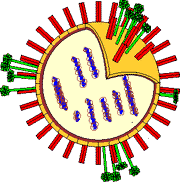29 January 2002
Researchers Turn Viruses Into Nano Building Blocks
by Kate Melville
 Using a combination of chemistry and molecular genetics, researchers at The Scripps Research Institute (TSRI) and The Skaggs Institute for Chemical Biology have found a way to attach a wide range of molecules to the surface of a virus, essentially enhancing the virus with the properties of those molecules. In the current issue of the journal Angewandte Chemie, scientists Qian Wang, Tianwei Lin, Liang Tang, John E. Johnson, and M.G. Finn describe their technique, which may find applications in materials science, medicine, and molecular electronics. One particularly tantalizing possibility is to build circuits of conducting molecules on the surfaces of the viruses and form a component of a molecular-scale computer, or a new type of "nanowire."
Using a combination of chemistry and molecular genetics, researchers at The Scripps Research Institute (TSRI) and The Skaggs Institute for Chemical Biology have found a way to attach a wide range of molecules to the surface of a virus, essentially enhancing the virus with the properties of those molecules. In the current issue of the journal Angewandte Chemie, scientists Qian Wang, Tianwei Lin, Liang Tang, John E. Johnson, and M.G. Finn describe their technique, which may find applications in materials science, medicine, and molecular electronics. One particularly tantalizing possibility is to build circuits of conducting molecules on the surfaces of the viruses and form a component of a molecular-scale computer, or a new type of "nanowire."
"What we demonstrated was that under the proper conditions, we can attach 60 molecules to the virus surface," says Johnson, who is a professor in TSRI's Department of Molecular Biology.
Finn, who is an associate professor in TSRI's Department of Chemistry and The Skaggs Institute for Chemical Biology, adds, "We can do selective organic chemistry, characterize the result, and bring new properties to the virus particle."
Nature is a master builder at the atomic level, and the field of nanotechnology seeks to mimic some of this craftsmanship on the molecular scale. The "nano" in nanotechnology refers to the greek prefix of nanometer, or one billionth of a meter-the yardstick by which molecules are measured.
The virus used in the study was a plant virus, called cowpea mosaic virus, which looks like a shell under the microscope. The shell is some 30 nanometers in diameter and is formed by 60 identical copies of a viral protein. It has an icosahedral shape, which provides 60 equivalent sites for attaching molecules.
As a biophysicist, Johnson has studied the structure and function of the virus for over two decades, and in recent years he has collaborated with molecular biologists to change the genetic makeup of the virus so as to add novel expressions to its 60 units.
In the current study, the researchers inserted a peptide (a short string of amino acids) that contains one particularly reactive amino acid residue called a cysteine. After the peptide is inserted, the structure of the virus shells remained unchanged, except that they displayed the reactive cysteines on its surface.
As a chemist, Finn knew just what to do with surface cysteines.
Through chemical manipulations, the cysteine was made to link to other molecules. The team attached fluorescent dyes and clusters of gold molecules to the cysteine residues because the dyes and the gold clusters could be easily imaged.
They call the current work a proof-of-principle, and it is by no means an end unto itself. They have also successfully attached biotin (Vitamin B), sugars, and organic chemicals. The technique can be used to immobilize large molecules on the viral surface-whole proteins even.
"We can attach anything we want to the surface of the virus," says Johnson.
In addition, Finn and Johnson found that cysteines could also be double-labeled by placing cysteine on both the inside and outside of the virus shell and then a pattern of attachment sites could be created that would allow for novel chemistry.
The stability, solubility, and the chromatographic properties of the virus can be altered at will, by adding the right molecules. And the virus particles can self-organize into network arrays in a crystal, which may make it a useful building block for various applications in nanotechnology.
"You can, in principle, determine the type of assembly you get by programming the building blocks," says Finn.
